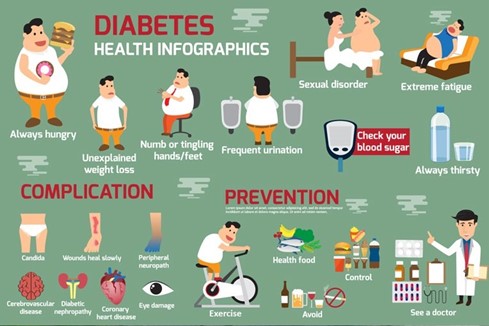The nurse is assessing a 55-yr-old female patient with type 2 diabetes who has a body mass index (BMI) of 31 kg/m2.Which goal in the plan of care is most important for this patient?
The patient will choose a diet that distributes calories throughout the day.
The patient will reach a glycosylated hemoglobin level of less than 7%.
The patient will follow a diet and exercise plan that results in weight loss.
The patient will state the reasons for eliminating simple sugars in the diet.
The Correct Answer is B
Glycosylated hemoglobin (HbA1c) is a measure of the average blood glucose levels over the past 2-3 months. An HbA1c level of less than 7% is associated with a reduced risk of microvascular and macrovascular complications in patients with diabetes. This is a critical goal because uncontrolled blood glucose levels can lead to complications such as neuropathy, nephropathy, retinopathy, and cardiovascular disease.
While options a, c, and d are also important in the management of diabetes, they are not as critical as achieving glycemic control. Choosing a diet that distributes calories throughout the day can help regulate blood glucose levels and prevent hypoglycemia. Following a diet and exercise plan that results in weight loss can also help improve glycemic control and reduce the risk of complications. Understanding the reasons for eliminating simple sugars in the diet is important for overall diabetes education, but it is not the most important goal in the plan of care for this patient at this time.

Nursing Test Bank
Naxlex Comprehensive Predictor Exams
Related Questions
Correct Answer is B
Explanation
Since the patient's pre meal blood sugar is 311 mg/dL, according to the sliding scale, the patient requires 8 units of Humalog insulin. Therefore, the nurse should administer 8 units of Humalog insulin before the patient's meal. It is important to note that if the patient's blood glucose level is greater than 400 mg/dL, the nurse should call the MD instead of administering insulin. Keeping the patient NPO (nothing by mouth) is not necessary in this situation, as the patient is awake, alert, and able to swallow, and will require their meal for adequate nutrition. However, it is important to monitor the patient's blood glucose level after administering insulin and adjust the dosage if necessary.
Correct Answer is ["A","B","C","D"]
Explanation
Use of a portable blood glucose monitor: The patient should be taught how to use a portable blood glucose monitor to check their blood glucose levels at home. This will help the patient monitor their blood glucose levels and adjust their insulin dose as necessary.
Hypoglycemia prevention, symptoms, and treatment: The patient should be taught about the signs and symptoms of hypoglycemia (low blood glucose levels) and how to treat it. This includes teaching the patient to consume 15-20 grams of fast-acting carbohydrates such as glucose tablets or juice when experiencing hypoglycemia.
Insulin administration: The patient should be taught how to administer insulin, including the timing of injections and rotating injection sites. The patient should also be educated about the importance of taking insulin regularly and the potential consequences of missed doses.
Diet: The patient should be educated about healthy eating habits that include monitoring carbohydrate intake, eating regular meals, and spacing carbohydrates throughout the day. The patient does not need to eliminate sugar entirely from their diet, but rather to consume it in moderation and balance it with other food groups.
Physical activity: The patient should be encouraged to engage in regular physical activity but may need to adjust their insulin dose or carbohydrate intake to accommodate for the changes in blood glucose levels that may result from physical activity. Reducing physical activity is not necessary, but rather adjusting to it properly with proper monitoring of glucose levels.

Whether you are a student looking to ace your exams or a practicing nurse seeking to enhance your expertise , our nursing education contents will empower you with the confidence and competence to make a difference in the lives of patients and become a respected leader in the healthcare field.
Visit Naxlex, invest in your future and unlock endless possibilities with our unparalleled nursing education contents today
Report Wrong Answer on the Current Question
Do you disagree with the answer? If yes, what is your expected answer? Explain.
Kindly be descriptive with the issue you are facing.
